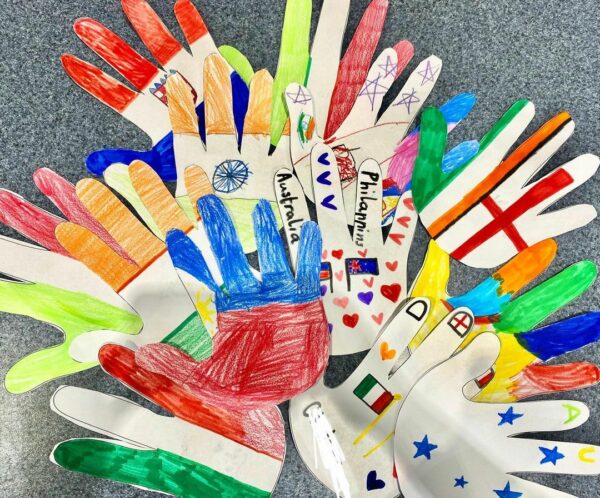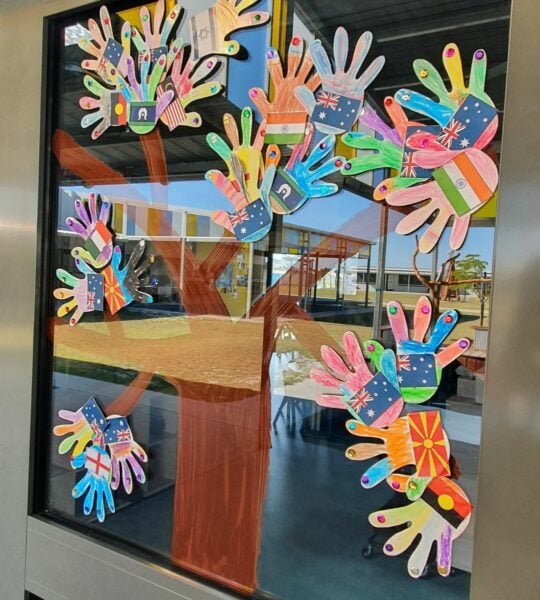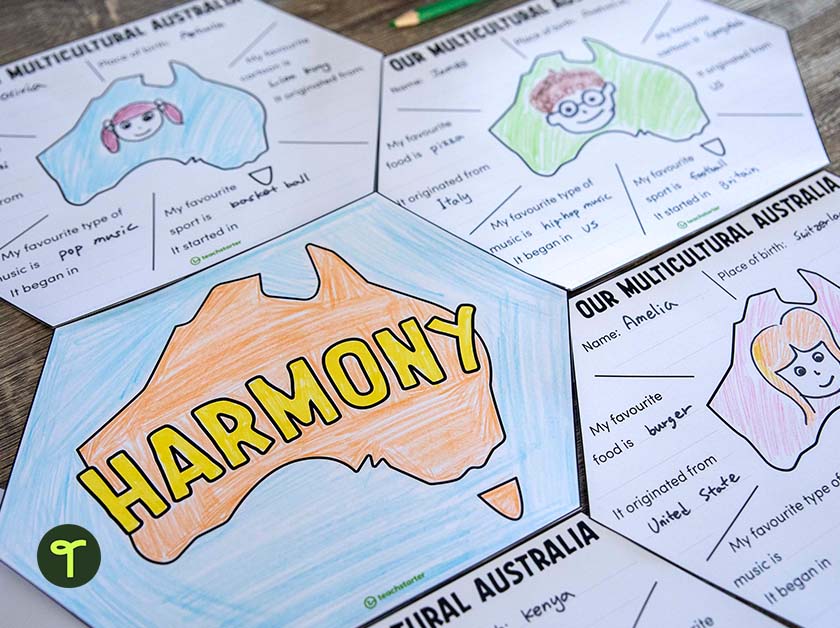Looking for Harmony Week activities to weave into your lesson plans this year? You’re in good hands! Harmony Week is a perfect opportunity for kids to recognise, respect and celebrate the different cultural backgrounds that make up each classroom and school. This year, the event is held Monday 18 – Sunday 24 March, and there are many activities for kids to get involved in to promote the message that ‘Everyone Belongs’ and weave in some important social emotional learning resources.
We know when March rolls around, you might be feeling inundated with everything on your plate, so our Teach Starter team has done hard yards and compiled a list of Harmony Week activities and ideas for your classroom, plus a list of books to read as a class.
Read on to find some easy Harmony Week ideas, from holding a scavenger hunt to planning an orange outfit day!
Don’t have a lot of time? Skip to our favourite Harmony Day printable resources!
Harmony Week Activities & Ideas for Schools
Decorate the Classroom
You already do your best to make your classroom a warm and welcoming place, and you don’t need to make big changes just for one week. However, adding a poster or classroom display that reinforces the importance of diversity is a great way to remind students what you stand for and what it means to be a part of a classroom community. Put it up for Harmony Week, and keep it up all school year to keep reminding students to value their classmates’ differences!
Need a Harmony Week craft that can double as a display? Queensland teacher Miss Hay shared this photo of the beautiful works of art her year 1 students made with our ‘handy’ Harmony Day Tree Craft template. The class had a great time ‘honouring our diverse cultures & respecting how we come together as one in our community,’ she said.
Image courtesy of Aussie Year 1 teacher @hey.misshay.
Why not use the handprints to create a mural, bunting or banner to celebrate the many cultures that make up your class?
Conduct a Research Project on a Multicultural Icon
Teaching upper years students? Task your class with researching and writing a brief biography on an individual from a multicultural background who has made significant contributions to Australian society or promotes inclusivity and a sense of belonging through their work.
You can help students get started by providing a list of people who fit the description, from advocates to artists to sporting figures. Students can present their biographies in poster formats and present to the class, introducing the icon and why they embody the spirit of Harmony Week.
Some icons you may consider adding to a list for students to choose from include:
- Cathy Freeman
- Adam Goodes
- Turia Pitt
- Anh Do
- Oodgeroo Noonuccal
- Dr. Munjed Al Muderis
- Penny Wong
- Marcia Langton
- Louise Mack
- Yassmin Abdel-Magied
Hold a Multicultural Scavenger Hunt
Kids love scavenger hunts, so why not incorporate one into your Harmony Week celebrations?
The scavenger hunt could encourage students to identify 10 to 15 items and places representing multicultural Australia around the school. You can even provide a map for students to locate each item. Here’s a list of possible locations at school where your students might find multicultural symbols:
- The classroom – Teachers often decorate their classrooms with posters, artwork and educational materials that showcase different cultures. Your scavenger hunt could include maps, flags, traditional clothing and photographs depicting diverse cultural practices and celebrations.
- The library – The school library is typically home to a wide range of books and resources from different cultures, including fiction and non-fiction books, folktales, language learning materials and multimedia resources that celebrate cultural diversity.
- Language learning centres – Do you offer language classes in your school? You might have dedicated areas where students can immerse themselves in different languages and cultures that can be stops on the hunt.
- School grounds and common areas – Have students look for displays, murals or exhibitions that celebrate multicultural events or student work that reflects diverse cultural backgrounds.
- School gardens – Spend time planting plants from various cultures in your school garden, teaching students about different environmental practices and traditional uses of plants in various cultures.
Organise an International Food Festival
Each student can bring dishes from different cultures to share – it can be a potluck-style event, and parents can also participate in the event. If the recipe holds significance to the ‘chef,’ encourage students to write a little note explaining why it is important to them to accompany the dish.
While this idea might sound like a lot of effort, you can lean on other staff members to organise the event together if organised early enough.
Plan an Orange Outfit Day
Orange is the official colour chosen to represent Harmony Week, and it’s meant to signify social communication and meaningful conversations. The colour also relates to freedom of ideas and encouragement of mutual respect.
Why not plan a day during Harmony Week for all students to wear orange as a sign of coming together as a classroom community? You may want to talk to admin to see if this can be done school-wide and ask other teachers to also wear orange for the day.
Don’t forget to add a note in your classroom newsletter to let parents know ahead of time!
Practise Acrostic Poetry for Harmony Day
Combine Harmony Week and a lesson on poetry in one activity! This is an easy idea for students to complete at their desks and will get them thinking about words associated with Harmony Week.
Print off our ‘Harmony’ Acrostic Poem template and give a copy to each child. To take the activity further, encourage each student to present their poem to the class and explain their choice of words.
Focus on Classroom Community
Harmony Week is about creating a sense that we all belong here in Australia, but you might want to take this time to look closer to home. Take the time to think about how you build that feeling in your classroom culture. After all, creating a sense of belonging in the classroom helps students feel valued, supported, and accepted, which in turn can lead to improved academic performance, better behaviour, and higher levels of engagement and motivation.
A few things to consider:
- Do you use diverse materials and resources that reflect the backgrounds and cultures of all students?
- Do you encourage student-led activities and discussions that promote empathy and understanding?
- Do you create opportunities for cross-cultural exchange and collaboration?
- Do you foster relationships with families and engage them in their child’s education?
One great way to remind students that their classroom is a community where everyone is valued is to create displays that include a representation of every child as an individual — not just their school work but themselves. This Harmony Tree Craft activity creates a simple, yet effective display that celebrates your students’ different backgrounds and cultures. Students use a hand template to represent themselves and their cultural background. The hands are then used to create a whole class harmony tree display.
Australian kindy teacher Lisa of @teach_survive_thrive has used our Harmony Tree Craft activity to create a wonderful door display to celebrate multiculturalism in her classroom.
Decorate Diversity Lotus Flowers
The growth of the lotus flower is often seen as a metaphor for spiritual development, as one grows and transforms through various challenges and obstacles to reach a state of enlightenment. That’s what makes it perfect for a Harmony Week activity in the classroom to represent your students’ growing understanding of different cultures and what makes each unique and special.
Just as we focus on Harmony Week to teach our students cultural diversity and inclusiveness, the lotus flower can be used as a symbol to represent these ideals because, like the flower, we can rise above adversity and bloom despite our differences.
Lead a discussion about cultural diversity in the classroom, then lead students in writing out some of the words that are most important when talking about diversity and inclusion on lotus flowers that can be used to create a classroom display.
You can print out this lotus flower template on orange card to represent the colour of Harmony Week (the lotus pad pages can be printed on green card).
Ready Your Class Performance
Will your school be putting on performances during Harmony Week? The song Everyone Belongs is an obvious fit for the theme, and it’s been written just for kids ages 5 through 12 with lyrics that encourage them to accept everyone and understand that we should live in harmony with our classmates, friends, and neighbours.
The song is a perfect choice if your class has been asked to perform in front of the school to celebrate Harmony Week, but even if you won’t be performing, it’s still a great song for your students to listen to in the classroom. After you listen, discuss the meaning of the lyrics with your students. The full lyrics are available at SongLibrary.
Explore Australian Multiculturalism
There are countless cultures within Australia, but how much do your students really know about the cultural origins of some of their favourite things? Do they realise, for example, that pizza comes from Italy? Do your maths students know that the numbers they are using every day have Arabic roots? Use Harmony Week as a chance to connect multi-culturalism in a very real and personal way for your students.
We’ve made this fun Harmony Day multicultural display that is made up of printable hexagon templates for students to fill out about themselves. After writing their name and where they were born, students write their favourite food, sport, cartoon and type of music. They then research the countries and cultures where each favourite originated.
They draw a self-portrait within the outline of Australia and add drawings or pictures of some of their favourite things. Once complete, they cut out the hexagonal shape, and you can create a tessellating display on a wall promoting Harmony Day.
Print the multicultural activity template here!
Teach Students How to Say Hello — In Different Languages
Teaching our students how to greet people in a variety of languages not only broadens their understanding and appreciation of different cultures but also helps them build their communication skills, making them more confident and effective when communicating with people from different cultures. Set aside time during Harmony Week for a lesson on how to say hello in a variety of languages that are spoken here in Australia and around the world. There’s no need to take up a lot of class time for this — you can even write a new greeting on your whiteboard each morning to launch a discussion.
No time to research all those hellos? Don’t worry! You can print a classroom poster right now that teaches kids how to say hello in 10 different languages!
Harmony Day Books to Read to Students
Harmony Day is a perfect opportunity for a read-along to help students understand and appreciate cultural diversity, fostering empathy and respect for people from different backgrounds. We’ve rounded up five children’s books that delve into topics of multiculturalism, inclusivity and diversity:
1. Mirror by Jeannie Baker
Suitable for Years 1 to 3, this beautiful picture book tells the story of two families — one in Australia and the other in Morocco. The parallel stories highlight the cultural similarities and differences between the families, encouraging kids to gain an understanding and learn empathy.
2. Whoever You Are by Mem Fox
This Mem Fox classic is a top pick to read during Harmony Week! Perfect for teaching acceptance and awareness to younger students, this illustrated book explores how kids around the world, living in different cultures, are very much alike on the inside.
3. My Two Blankets by Irena Kobald
The heartwarming story follows the story of a young girl who moves to a new country and feels displaced by having to learn a new language and fit into the culture. She finds comfort in her old blanket but slowly creates a new blanket of words and sounds from her new home. This is a great book to help students in Years 2 to 4 learn cultural acceptance and work on teaching about metaphors while you’re at it!

4. The Name Jar by Yangsook Choi
Focusing on identity and cultural pride, this lovely book tells the story of a Korean girl who moves to America and is worried that no one will be able to pronounce her name. As she decides whether to choose a new name, she learns to appreciate her own unique name and heritage.
5. Say Hello by Jack and Michael Foreman
Perfect for Prep to Year students, ‘Say Hello’ promotes inclusivity and kindness in a simple, engaging way. It encourages kids to say hello to others, regardless of their language or nationality and highlights the joy of making new friends by being kind and friendly.
6. Wombat Stew by Marcia K. Vaughan
Wombat Stew is a quintessential Australian children’s book and one that is perfect to read to your class during Harmony Week. While not directly about cultural diversity, the book can be used in the classroom to discuss the importance of collaboration, friendship, and the rich natural and cultural heritage of Australia through characters portrayed by different Australian animals.














Comments